History
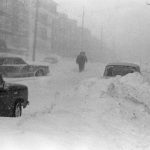
 As the United States is in the grip of a fierce snow storm, I am reminded of another snow storm that happened February 21 – 23, 1971. The storm is considered Oklahoma’s extreme storm. This blizzard buried northwestern Oklahoma under as much as three feet of snow, and that doesn’t include the drifting. The town of Buffalo was the hardest hit. They reported 23 inches of snow on the 21st alone, and a state-record snow depth of 36 inches by the morning of the 24th. The northern part of the state was just buried.
As the United States is in the grip of a fierce snow storm, I am reminded of another snow storm that happened February 21 – 23, 1971. The storm is considered Oklahoma’s extreme storm. This blizzard buried northwestern Oklahoma under as much as three feet of snow, and that doesn’t include the drifting. The town of Buffalo was the hardest hit. They reported 23 inches of snow on the 21st alone, and a state-record snow depth of 36 inches by the morning of the 24th. The northern part of the state was just buried.
Oklahoma tends to be a mild weather state, with temperatures in December, January, and February averaging in the 50s. This week is the anniversary of the 1971 blizzard, which was likely the most intense winter storm ever to hit the Sooner State, although the current storm might rival it now. With the current storm, Oklahoma is seeing temperatures averaging -6°. The prior record was in 1909 at 7°. The power company had had to implement rolling blackouts to assure that the power grids don’t fail. I don’t think they have received the amount of snow with the current storm, but the severity is very similar, when you think about it. Anytime a storm is is bad enough to shut things down, especially the power, it is severe.
When the blizzard of 1971 finally ended, 36 inches of snow was measured in Buffalo, which was the state’s record for the highest snowfall total, but the snow drifts measured as high as 20 feet tall. While northwestern Oklahoma was hit very hard, just a short distance to the west in the Oklahoma Panhandle, only light snow fell with Boise City receiving only 3 inches and only 2 inches in Kenton. The 1971 storm put ranchers in a precarious position until C-124s from the Oklahoma Air National Guard dropped 150 tons of hay to stranded Oklahoma cattle. Local cattleman flew along with the aircraft to guide the aircrews to the stranded cattle. The massive loss numbers of 15,000 in livestock accounted for much of the $2 million in damages.
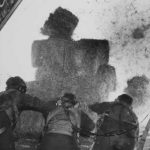
 The vicious storm became known as the 84-hour blizzard. It actually occurred across the eastern half of the Texas and Oklahoma Panhandles. The storm his the worst un Oklahoma, but in the region, 8 deaths were reported…7 in Pampa, 1 in the Oklahoma Panhandle. The average drifts were 10 to 20 feet. Storms like these will not likely be soon forgotten, if they are ever forgotten. People are really never prepared for such cold temperatures and so much snow in the southern states. We can try to prepare, but when year after year goes by without such a sever storm, we soon become complacent, until the next one hits us, that is.
The vicious storm became known as the 84-hour blizzard. It actually occurred across the eastern half of the Texas and Oklahoma Panhandles. The storm his the worst un Oklahoma, but in the region, 8 deaths were reported…7 in Pampa, 1 in the Oklahoma Panhandle. The average drifts were 10 to 20 feet. Storms like these will not likely be soon forgotten, if they are ever forgotten. People are really never prepared for such cold temperatures and so much snow in the southern states. We can try to prepare, but when year after year goes by without such a sever storm, we soon become complacent, until the next one hits us, that is.
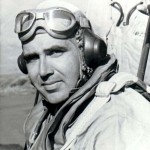
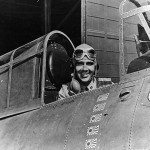 When a war begins, I doubt if anyone is thinking about the medals or the honors they might receive, because what they really want is for the war to be over already. Nobody enjoys going to war…not even the one who starts the war. There are never any guarantees that you will come out of a war alive, so most people would rather not go at all. Nevertheless, when a soldier goes into war, he or she has taken a vow to do their very best, and to fight to the death, if necessary. When World War II got started, the United States really intended to stay out of it. They vowed to stay neutral…until the Japanese attacked Pearl Harbor in Hawaii. Once the United States entered World War II, however, we were in it to win it.
When a war begins, I doubt if anyone is thinking about the medals or the honors they might receive, because what they really want is for the war to be over already. Nobody enjoys going to war…not even the one who starts the war. There are never any guarantees that you will come out of a war alive, so most people would rather not go at all. Nevertheless, when a soldier goes into war, he or she has taken a vow to do their very best, and to fight to the death, if necessary. When World War II got started, the United States really intended to stay out of it. They vowed to stay neutral…until the Japanese attacked Pearl Harbor in Hawaii. Once the United States entered World War II, however, we were in it to win it.
Lieutenant Edward O’Hare, an American naval aviator of the United States Navy, was born on March 13, 1914 in Saint Louis, Missouri, to Selma Anna (Lauth) and Edward Joseph O’Hare. He was of Irish and German descent. Edward, who was nicknamed “Butch,” had two sisters, Patricia and Marilyn. Their parents divorced in 1927. Butch and his sisters stayed with their mother in Saint Louis, and their father moved to Chicago. O’Hare joined the Navy, and from there, life moved pretty fast. On July 21, 1941, O’Hare met his future wife, Rita and asked her to marry him that night. He knew immediately that she was the one. They got married on September 6, 1941 and their daughter, Kathleen was born in January or February of 1943. O’Hare first met her when she was a month old, because of missions he was on.
In the Navy, O’Hare was stationed first on the USS Saratoga, then on the USS Enterprise, and then on the USS Lexington, flying a Grumman F4F-3 Wildcat. In mid-February 1942, the Lexington sailed into the Coral Sea. A town named Rabaul, at the very tip of New Britain, one of the islands that comprised the Bismarck Archipelago, had been invaded in January by the Japanese and transformed into a stronghold. In fact, it had been turned into one huge airbase. The occupation of Rabaul put the Japanese in prime striking position for the Solomon Islands, which would have been put them in a perfect position for expanding their ever-growing Pacific empire. Given the mission of destabilizing the Japanese position on Rabaul with a bombing raid, the fighters on the Lexington took off from the aircraft carrier’s deck in a raid against the Japanese position at Rabaul. Just moments later, Lieutenant O’Hare became America’s first World War II flying ace. In the battle that took place on February 20, 1942, O’Hare believed he had shot down six bombers and damaged a seventh. Captain Frederick C Sherman later reduced that number to five, as four of the reported nine bombers were still overhead when he pulled off. Nevertheless, in the opinion of Admiral Brown and of Captain Sherman, commanding the Lexington, Lieutenant O’Hare’s actions may have saved the carrier from serious damage or even loss. In a mere four minutes, O’Hare shot down five Japanese G4M1 Betty bombers, bringing a swift end to the Japanese attack and earning O’Hare the designation “Ace,” which was given to any pilot who had five or more downed enemy planes to his credit. The attack on the bombers was great, but it ruined the element of surprise, so the mission was called off.
On the night of November 26, 1943, the USS Enterprise introduced the experiment in the co-operative control of Avengers and Hellcats for night fighting. The team consisted of three planes, breaking up a large group of land-based bombers. O’Hare volunteered to lead this mission to conduct the first-ever Navy nighttime fighter 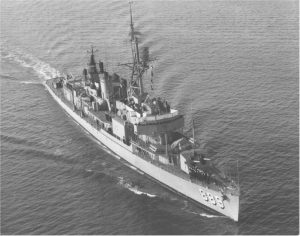
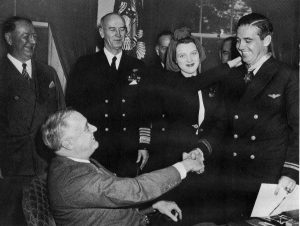 attack from an aircraft carrier to intercept a large force of enemy torpedo bombers. When the call came to man the fighters, Butch O’Hare was eating. He grabbed up part of his supper in his fist and started running for the ready room. It was to be his final mission. When it was over, O’Hare was missing in action. He was declared dead a year later. The airport in Chicago and a destroyer would later be named in his honor. He lived life fast and died young, but he was always in it to win it.
attack from an aircraft carrier to intercept a large force of enemy torpedo bombers. When the call came to man the fighters, Butch O’Hare was eating. He grabbed up part of his supper in his fist and started running for the ready room. It was to be his final mission. When it was over, O’Hare was missing in action. He was declared dead a year later. The airport in Chicago and a destroyer would later be named in his honor. He lived life fast and died young, but he was always in it to win it.
 I realize that many people, me included, would have no desire to explore the inside of a volcano, but for scientists of volcanos…volcanologists, it is somehow important. A dormant volcano would be fairly easy to explore. There is less chance of getting caught in an eruption, but for one that isn’t dormant, it isn’t so easy. I don’t think I would want to try to explore Kilauea, because…well, it goes up all the time. Another very active volcano, Kavachi is not only active, but it is underwater. Kavachi is located in the south-west Pacific Ocean, south of Vangunu Island in the Solomon Islands. and is referred to locally as Rejo te Kavachi, meaning “Kavachi’s oven.” Kavachi has become active and then eroded back into the sea at least eight times since its first recorded eruption in 1939.
I realize that many people, me included, would have no desire to explore the inside of a volcano, but for scientists of volcanos…volcanologists, it is somehow important. A dormant volcano would be fairly easy to explore. There is less chance of getting caught in an eruption, but for one that isn’t dormant, it isn’t so easy. I don’t think I would want to try to explore Kilauea, because…well, it goes up all the time. Another very active volcano, Kavachi is not only active, but it is underwater. Kavachi is located in the south-west Pacific Ocean, south of Vangunu Island in the Solomon Islands. and is referred to locally as Rejo te Kavachi, meaning “Kavachi’s oven.” Kavachi has become active and then eroded back into the sea at least eight times since its first recorded eruption in 1939.
It is very strange to me to see pictures and videos of volcano erupting in the middle of the ocean. It seems so unnatural that fire and water could mix and the water not put out the fire. It’s a strange concept, but one that has baffled me for years. I think that the thought of fire and water has maybe been the curiosity behind the exploration of these underwater volcanoes. In May 2000, an international research team aboard the CSIRO 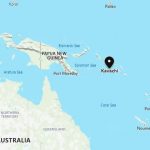 research vessel Franklin fixed the Kavachi volcano at 8° 59.65’S, 157° 58.23’E. The vent of the volcano was below sea level, but frequent eruptions ejected molten lava up to 230 feet above sea level, and sulfurous steam plumes up to 1,600 feet. The team mapped a roughly conical feature rising from 3,600 feet water depth, with the volcano having a basal diameter of about 5.0 miles. Of course, underwater volcanoes were the foundation of the Hawaiian Islands, so it is not a odd idea that when the Kavachi volcano erupted in 2003, a 49-foot island formed above the surface. The small island disappeared a short time later, so I suppose the volcano would have to erupt almost constantly in order to form an island that would last.
research vessel Franklin fixed the Kavachi volcano at 8° 59.65’S, 157° 58.23’E. The vent of the volcano was below sea level, but frequent eruptions ejected molten lava up to 230 feet above sea level, and sulfurous steam plumes up to 1,600 feet. The team mapped a roughly conical feature rising from 3,600 feet water depth, with the volcano having a basal diameter of about 5.0 miles. Of course, underwater volcanoes were the foundation of the Hawaiian Islands, so it is not a odd idea that when the Kavachi volcano erupted in 2003, a 49-foot island formed above the surface. The small island disappeared a short time later, so I suppose the volcano would have to erupt almost constantly in order to form an island that would last.
Of course, that strangest thing about Kavachi is that while the volcano is quite active, it has another strange anomaly to it. In 2015, marine life has been found living inside the Kavachi crater, including two species of sharks and a sixgill stingray. It seems so strange that they could live in an environment that must be quite acidic. The scientists haven’t been able to go in and explore yet, because of the possibility of an eruption.  Finally they took a chance and dropped a camera into the volcano. Concerned about activity from the volcano, the expedition members only left the camera in the hot, acidic water around the volcano for about an hour. Still, it was all they needed to find the wildlife inside. Of course, during an eruption, there is no way this marine life could live inside the volcano. That makes me wonder if they somehow know the eruption is coming so they can get out, or do they simply die when an eruption occurs. That somehow doesn’t seem like the case, because eventually there would be no more marine life in the volcano. I guess that is just a question we will probably never have an answer to.
Finally they took a chance and dropped a camera into the volcano. Concerned about activity from the volcano, the expedition members only left the camera in the hot, acidic water around the volcano for about an hour. Still, it was all they needed to find the wildlife inside. Of course, during an eruption, there is no way this marine life could live inside the volcano. That makes me wonder if they somehow know the eruption is coming so they can get out, or do they simply die when an eruption occurs. That somehow doesn’t seem like the case, because eventually there would be no more marine life in the volcano. I guess that is just a question we will probably never have an answer to.
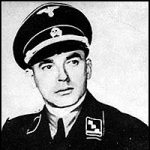
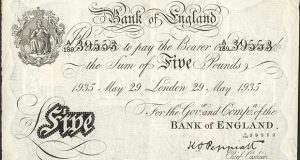 When we think of the weapons of warfare, we think of guns, planes, tanks, and such, but there are weapons of warfare that while seemingly far less lethal, are still deadly…in other ways. Economic warfare is something I would never have considered, even though it makes perfect sense. The Germans in World War II thought of every possible weapon, or very close to it. If a nation has no money to bankroll a war, they are very likely going to lose. That was the position that Germany wanted to put Great Britain in during World War II. They decided on an age-old plan…if you’re a criminal that is. Counterfeiting money to tank the economy.
When we think of the weapons of warfare, we think of guns, planes, tanks, and such, but there are weapons of warfare that while seemingly far less lethal, are still deadly…in other ways. Economic warfare is something I would never have considered, even though it makes perfect sense. The Germans in World War II thought of every possible weapon, or very close to it. If a nation has no money to bankroll a war, they are very likely going to lose. That was the position that Germany wanted to put Great Britain in during World War II. They decided on an age-old plan…if you’re a criminal that is. Counterfeiting money to tank the economy.
The year was 1942 and for the purpose of artificially causing inflation of the British pound, leading to the economic collapse of the competition, while simultaneously funding some of their own projects, the production of the British “White Notes” was about to start. It would not start in Britain, however. These “White Notes” would be made behind the gates of Sachsenhausen concentration camp. The Germans decided to begin counterfeiting British banknotes. These tactics were considered particularly wrong by the German soldiers themselves, basically sneaky and unprofessional. However, soon after World War II, it became common practice for different countries to counterfeit the currency of their opposition in times of war. Evil knows no bounds.
The first attempt at counterfeiting, known as Operation Andrew, failed because of disagreements between top brass inside of the Nazi Party. Friederich Walter Bernhard Krueger was placed in charge of Germany’s second attempt at counterfeiting British notes. The second operation’s codename was Bernhard because that is what Krueger was called. In preparation for the production, Bernhard assembled a team of about 140 men/prisoners. Some historians have suggested that it was as many as 300. These men were told they would receive better treatment and special perks like radio, newspapers, warm barracks, if they participated in the operation. The men had nothing to lose. All they had to do was counterfeit 400,000 British banknotes a month.
After a year of hard work, and the prisoners finally successfully counterfeited the British White Note. By 1945, conservative estimates figure 70,000,000 notes were printed by the inmates. It was a cache worth upwards of £100,000,000. In order to complete this herculean task, the team of counterfeiters studied vast quantities of authentic White Notes. They broke this massive task up into seven smaller tasks, each one seemingly more difficult than the last. “These tasks included: Discovering secret security marks, Engraving the vignette, Perfecting the paper, Creating identical ink, Solving the serial numbering system, Re-creating the signatures, dates and places of origin, and Printing the notes. The men found no fewer than 150 different security marks hidden on the White Notes. There were intentional minor defects and flaws that the Bank of England incorporated as anti-counterfeiting devices. To make things even harder, these security devices were different for each denomination. Nonetheless, in short order, the counterfeit team produced a plate for each denomination: £5, £10 £20 and £50.” The plan was coming together and soon they were ready to execute it.
The plan was to fly over and drop the counterfeit money from the planes. Once it was laundered and in the hands of the people, they could spend it and because there was no real backing for the money, the economy would tank. The operation went on for a time, but with the late February and early March 1945 advance of the Allied armies, all production of notes at Sachsenhausen ceased. The equipment and supplies were packed and transported, with the prisoners, to the Mauthausen-Gusen concentration camp in Austria, arriving on 12 March. 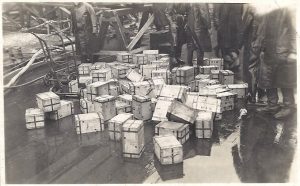
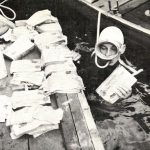 They had to hide the evidence. They didn’t give up on the process, however. Shortly afterwards Krüger arranged a transfer of the equipment to the Redl-Zipf series of tunnels so production could be restarted. The order to resume production was soon rescinded, however, and the prisoners were ordered to destroy the cases of money they had with them. The equipment and any money not burned was loaded onto trucks and sunk in the Toplitz and Grundlsee lakes.
They had to hide the evidence. They didn’t give up on the process, however. Shortly afterwards Krüger arranged a transfer of the equipment to the Redl-Zipf series of tunnels so production could be restarted. The order to resume production was soon rescinded, however, and the prisoners were ordered to destroy the cases of money they had with them. The equipment and any money not burned was loaded onto trucks and sunk in the Toplitz and Grundlsee lakes.
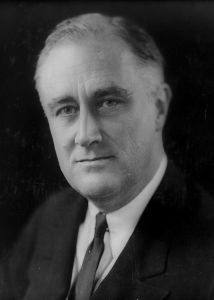
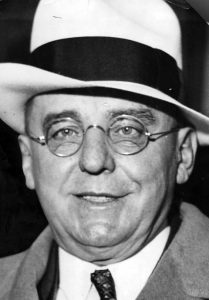 On February 15, 1933, following his return from a fishing trip in the Bahamas, President Franklin Delano Roosevelt was met by a large crowd of thousands of people. The crown was so excited to see the president, but they soon found themselves in the middle of a terrifying situation. Suddenly, before their eyes shooting began. Giuseppi Zangara, an anarchist gunman opened fire, in an attempt to assassinate President Elect Franklin D Roosevelt. Zangara shouted, “Too many people are starving!” Of course, the driving force behind the attack was the Great Depression. People were starving, jobs had been lost, banks were going under, and true depression had set in. Desperation was the next step.
On February 15, 1933, following his return from a fishing trip in the Bahamas, President Franklin Delano Roosevelt was met by a large crowd of thousands of people. The crown was so excited to see the president, but they soon found themselves in the middle of a terrifying situation. Suddenly, before their eyes shooting began. Giuseppi Zangara, an anarchist gunman opened fire, in an attempt to assassinate President Elect Franklin D Roosevelt. Zangara shouted, “Too many people are starving!” Of course, the driving force behind the attack was the Great Depression. People were starving, jobs had been lost, banks were going under, and true depression had set in. Desperation was the next step.
President Roosevelt had just delivered a speech in Miami’s Bayfront Park from the back seat of his open touring car when Zangara opened fire with six rounds. While Zangara missed the president, five people were hit. One of those hit was the mayor of Chicago, Anton Cermak, who was also in attendance. The mayor received a mortal stomach wound in the attack. While every attempt possible was used to try to save the mayor’s life, he later died of his wounds. Four other bystanders were also wounded. One of them, a woman, is was not expected to recover.
Thousands of people witnessed the shooting, which occurred in a dense crowd at Biscayne park on the Miami water front. The people acted quickly. A woman named Mrs W F Cross, of Miami was the first to seize the assassin’s gun. Zangara was quickly captured after that and people in the crowd began to beat him severely. The men that had tackled the assailant, might have beaten him to death, if Roosevelt had not intervened, telling the crowd to leave justice to the authorities. At police headquarters he was found to be of maniacal anarchistic tendencies. He ranted, “I like Roosevelt, all right, but I don’t like presidents.” President Roosevelt, who had stayed to speak to Mayor Cermak after the speech, immediately got Cermak into the Presidential Limousine and rushed him to the hospital. Cermak told the president that he was glad it was him and not the president. Noble words from a man who was about to die. Mayor Cermak, who did not lose consciousness during any of the time prior to being put on the operating table, was wounded by a single bullet which entered his back just above the right kidney.
For a time there were reports that the gunman might have been a Chicago gangster sent down here to murder 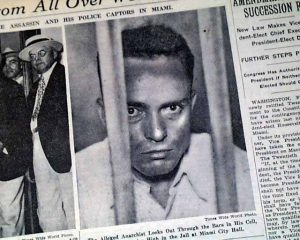
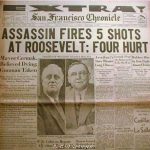 Mayor Cermak, but the subsequent developments showed that was not the case. Zangara was initially tried for attempted murder and sentenced to 80 years in prison, but when Mayor Cermak later died of his wounds, Zangara was retried and sentenced to death. Zangara died on the electric chair on March 20, 1933. I find myself amazed that his death came so quickly after his conviction. Most often it takes years to put someone to death. Nevertheless, just over a month later, the execution took place. At least that one time, justice was swift.
Mayor Cermak, but the subsequent developments showed that was not the case. Zangara was initially tried for attempted murder and sentenced to 80 years in prison, but when Mayor Cermak later died of his wounds, Zangara was retried and sentenced to death. Zangara died on the electric chair on March 20, 1933. I find myself amazed that his death came so quickly after his conviction. Most often it takes years to put someone to death. Nevertheless, just over a month later, the execution took place. At least that one time, justice was swift.
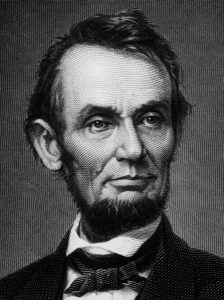 With Abraham Lincoln’s birthday just behind us…he was born on February 12, 1809. Most of us know that Lincoln had no formal education. We know that he gave amazing speeches and that he freed the slaves. We also know that he was assassinated, but there are a number of other Lincoln Facts that I didn’t know, and maybe you didn’t either. One sad fact is that Lincoln lost his mother at the tender age of 9 years old, when she drank poison milk. She wasn’t poisoned, but it turns out that many people died of a strange “milk sickness” that was caused by a cow eating a “poisonous to humans” plant called White Snakeroot. I’m sure it was a horrible time for Lincoln, but his father remarried, and the widow, Sarah Bush Johnston was a kind woman, who got along well with her step-son.
With Abraham Lincoln’s birthday just behind us…he was born on February 12, 1809. Most of us know that Lincoln had no formal education. We know that he gave amazing speeches and that he freed the slaves. We also know that he was assassinated, but there are a number of other Lincoln Facts that I didn’t know, and maybe you didn’t either. One sad fact is that Lincoln lost his mother at the tender age of 9 years old, when she drank poison milk. She wasn’t poisoned, but it turns out that many people died of a strange “milk sickness” that was caused by a cow eating a “poisonous to humans” plant called White Snakeroot. I’m sure it was a horrible time for Lincoln, but his father remarried, and the widow, Sarah Bush Johnston was a kind woman, who got along well with her step-son.
At the age of 21, Abraham Lincoln became a champion wrestler. I don’t know how he would have fared in WWE, but then that is a lot of drama and show too. Nevertheless, he wrestled in approximately 300 matches, and only lost once. It is thought that his long legs helped him lock his opponent down. Lincoln reportedly talked a little smack in the ring too. According to Carl Sandburg’s biography of Lincoln, “Honest Abe once challenged an entire crowd of onlookers after dispatching an opponent: ‘I’m the big buck of this lick. If any of you want to try it, come on and whet your 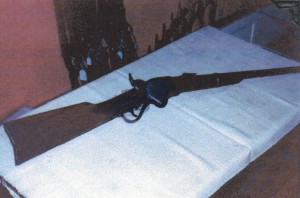 horns.’ There were no takers.” Lincoln’s grappling exploits earned him an “Outstanding American” honor in the National Wrestling Hall of Fame.
horns.’ There were no takers.” Lincoln’s grappling exploits earned him an “Outstanding American” honor in the National Wrestling Hall of Fame.
Lincoln is also the only president to have personally test-fired rifles outside the White House, including one by my ancestor, Christopher Spencer who was the inventor of the Spencer Repeating Rifle. When Spencer signed his new rifle up for adoption right after the Civil War broke out, it was not well received by the Department of War Ordnance, that felt soldiers would waste ammunition by firing too rapidly with repeating rifles. The unit was also more expensive than Springfield Model 1861 rifled musket in use at the time. Nevertheless, shortly after the famous Battle of Gettysburg, Spencer was able to gain an audience with President Abraham Lincoln, who invited him to a shooting match and demonstration of the weapon on the lawn of the White House. President Lincoln was so impressed with the weapon that he ordered General James Wolfe Ripley to adopt it for production. 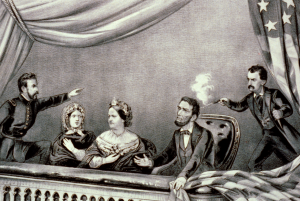 Unfortunately, Ripley disobeyed the order and continued to use the old single-shooters.
Unfortunately, Ripley disobeyed the order and continued to use the old single-shooters.
President Lincoln is also responsible for the safety of the presidents that followed him. Yes, there were failures, but without Lincoln’s decision to create the Secret Service on April 14, 1865, just hours before he was assassinated, many presidents in the future would not have had the quality of protection they did. The Secret Service did protect President Lincoln after his death, when grave robbers attempted to steal his body and hold it for a ransom of $200,000 and the release of one of their gang from prison. Their attempt was foiled by the Secret Service that President Lincoln had initiated.
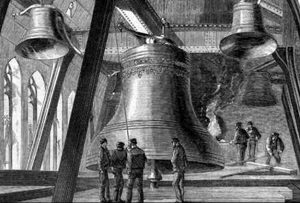 When you think of Big Ben, many of us think of a tower in London…or at least I did. The reality is that Big Ben isn’t the tower at all…it’s the bell. The tower is actually called the Elizabeth Tower…at least since 2012 when it was renamed that in honor of the current Queen Elizabeth. Prior to 2012, the tower was just called “the clock tower.” That was it’s official name, but it was nicknamed Saint Stephen’s tower. It’s funny that we can associate a specific name or idea to something, and have the whole thing totally wrong. The tower name is an interesting story, but that is not the only oddity when it comes to Big Ben.
When you think of Big Ben, many of us think of a tower in London…or at least I did. The reality is that Big Ben isn’t the tower at all…it’s the bell. The tower is actually called the Elizabeth Tower…at least since 2012 when it was renamed that in honor of the current Queen Elizabeth. Prior to 2012, the tower was just called “the clock tower.” That was it’s official name, but it was nicknamed Saint Stephen’s tower. It’s funny that we can associate a specific name or idea to something, and have the whole thing totally wrong. The tower name is an interesting story, but that is not the only oddity when it comes to Big Ben.
As interesting as that was to me, I find it even more interesting to find out that there is actually a prison in the tower. A third of the way, or 114 steps up inside the tower is the Prison Room, where MPs in breach of codes of conduct were imprisoned. The prison room was last used in 1880 when 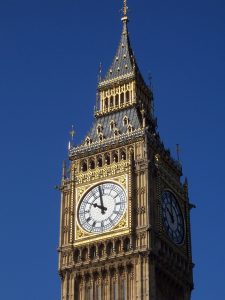 newly elected MP Charles Bradlaugh, who was an atheist, refused to swear allegiance to Queen Victoria on the Bible. He was kept in the prison room overnight. These days there is a pub named after him in Northampton. I’m not sure how many more people were imprisoned there, but it is certainly a strange use for a clock tower.
newly elected MP Charles Bradlaugh, who was an atheist, refused to swear allegiance to Queen Victoria on the Bible. He was kept in the prison room overnight. These days there is a pub named after him in Northampton. I’m not sure how many more people were imprisoned there, but it is certainly a strange use for a clock tower.
There are 334 steps over 11 floors up to the belfry…399 up to the lantern of the Elizabeth Tower. Each clock face measures 23 feet in diameter. The minute hand on each clock face is 14 feet long, and the hour hand is 9 feet long. The main bell weighs 13.7 tons and is 9 feet in diameter. There are four quarter bells that are smaller. These have different dimensions to enable them to hit different notes. At the top of the tower is an extra light called the Ayrton Light. It was installed so Queen Victoria could see when the members of parliament were sitting after hours.
The current bell is not the original bell. The original bell was famously cast at Whitechapel Bell Foundry. The contract to create the bell went to a company called Warners of Norton in Stockton-on-Tees. A 16.5 ton bell was created and delivered to London before the clock tower was ready. For several months, the bell was tested outside the tower. It was working fine until the man who designed it, Edmund Beckett Denison, decided he 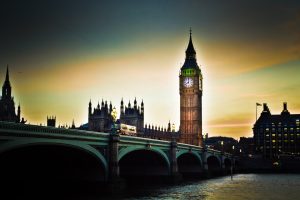 wanted it louder so added a much larger hammer. Three weeks later the bell broke. It was sent to Whitechapel Bell Foundry in pieces and melted down to create the new 13.5 ton bell. Once complete, it took 32 hours to winch it up the tower. Just two months after the bell named Big Ben first went into service in 1859, it was cracked. The hammer that was installed to ring the bell was roughly twice the size it should have been for a bell of that size. Nevertheless, the damage was done. The bell remains flawed to this day. A lighter hammer was fitted, and the bell was rotated slightly so that the hammer no longer hits the cracked section. The clock uses penny weights to keep the time accurate.
wanted it louder so added a much larger hammer. Three weeks later the bell broke. It was sent to Whitechapel Bell Foundry in pieces and melted down to create the new 13.5 ton bell. Once complete, it took 32 hours to winch it up the tower. Just two months after the bell named Big Ben first went into service in 1859, it was cracked. The hammer that was installed to ring the bell was roughly twice the size it should have been for a bell of that size. Nevertheless, the damage was done. The bell remains flawed to this day. A lighter hammer was fitted, and the bell was rotated slightly so that the hammer no longer hits the cracked section. The clock uses penny weights to keep the time accurate.
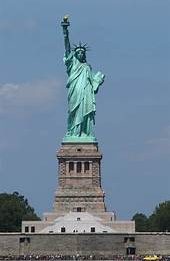 I have been to and inside the Statue of Liberty, and it is a place I’ll never forget. I was a teenager at the time, but I can still vividly picture the inside, as well as the outside. I think the thing that most stuck in my head is that to go up into the statue was a rather tight corridor. The arm was closed when we were there, but we didn’t really know why. For a time, especially after 9-11, no one was allowed to go into the Statue of Liberty at all, for fear of another terrorist attack.
I have been to and inside the Statue of Liberty, and it is a place I’ll never forget. I was a teenager at the time, but I can still vividly picture the inside, as well as the outside. I think the thing that most stuck in my head is that to go up into the statue was a rather tight corridor. The arm was closed when we were there, but we didn’t really know why. For a time, especially after 9-11, no one was allowed to go into the Statue of Liberty at all, for fear of another terrorist attack.
Prior to the 9-11 concerns, the Statue of Liberty was examined by French and American engineers for structural stability in 1982, as part of the planning for its centennial in 1986. Following the examination, it was announced that the statue was in need of considerable restoration. Careful examination had revealed that the right arm  had been improperly attached to the main structure. It was swaying more and more when strong winds blew and there was a significant risk of structural failure. This is information that I’m thankful I didn’t have when I went up into the statue in 1973. I recall being disappointed that we couldn’t go up in the arm then, but apparently they knew of the issues even then. Of further concern, the head had been installed 2 feet off center, and one of the rays was wearing a hole in the right arm when the statue moved in the wind. All the problems warranted the repairs done in 1984. She also got a nose job and her arm was shifted slightly to a better position. This information, though not well know, was really bad news, when you think about it. The statue had been standing in this place for 96 years by the time these flaws were discovered. Imagine what could have happened, especially with the arm improperly
had been improperly attached to the main structure. It was swaying more and more when strong winds blew and there was a significant risk of structural failure. This is information that I’m thankful I didn’t have when I went up into the statue in 1973. I recall being disappointed that we couldn’t go up in the arm then, but apparently they knew of the issues even then. Of further concern, the head had been installed 2 feet off center, and one of the rays was wearing a hole in the right arm when the statue moved in the wind. All the problems warranted the repairs done in 1984. She also got a nose job and her arm was shifted slightly to a better position. This information, though not well know, was really bad news, when you think about it. The statue had been standing in this place for 96 years by the time these flaws were discovered. Imagine what could have happened, especially with the arm improperly 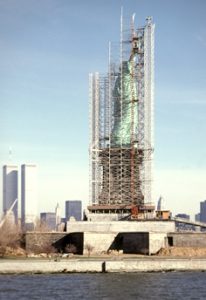 installed. The armature structure was badly corroded, and about two percent of the exterior plates needed to be replaced. Although problems with the armature had been recognized as early as 1936, when cast iron replacements for some of the bars had been installed, much of the corrosion had been hidden by layers of paint applied over the years. The whole statue was literally a ticking time bomb. Following the repairs, the statue would be much safer and could again be used, but that was not the end of her secrets.
installed. The armature structure was badly corroded, and about two percent of the exterior plates needed to be replaced. Although problems with the armature had been recognized as early as 1936, when cast iron replacements for some of the bars had been installed, much of the corrosion had been hidden by layers of paint applied over the years. The whole statue was literally a ticking time bomb. Following the repairs, the statue would be much safer and could again be used, but that was not the end of her secrets.
Most people think that the Statue of Liberty was a gift from the nation of France, and while it did come from France, it was actually partly a gift from the manufacturer in France (not the French nation). on top of that, Americans had to pay for the pedestal and partly contributed to the cost of the statue itself. Fundraisers were held in Boston and Philadelphia, in order to win the right to have the statue, but in the end, it went to New York. I’m sure many people who helped with the fundraising were very disappointed. This was another secret of the Statue of Liberty that I did not know.
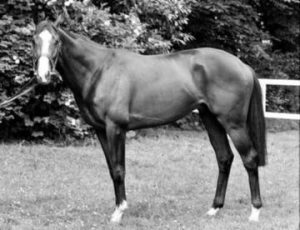 Shergar was a racehorse with the possibility for a great future as a stud horse following his 1981 retirement, but that future was cut short on February 8, 1983, when he was stolen. Shergar was born on March 3, 1978. He was an Irish-bred, British-trained thoroughbred racehorse. Shergar’s owner, The Aga Khan, sent the horse for training in Britain in 1979 and 1980. Shergar began his first season of racing in September 1980 and ran two races that year. He won one and came second in the other. Then, in 1981 he ran in six races, winning five of them. He was an amazing horse. In June that year, he won the 202nd Epsom Derby by ten lengths, which is the longest winning margin in the race’s history. Three weeks later he won the Irish Sweeps Derby by four lengths; a month after that he won the King George VI and Queen Elizabeth Stakes by four lengths. In his final race of the year he came in fourth, and the Aga Khan took the decision to retire him to stud in Ireland. I suppose that like many sports, there is a short window of opportunity with a racehorse, although it seems to me that Shergar had a very short career, but a promising future in stud service to breed racehorses.
Shergar was a racehorse with the possibility for a great future as a stud horse following his 1981 retirement, but that future was cut short on February 8, 1983, when he was stolen. Shergar was born on March 3, 1978. He was an Irish-bred, British-trained thoroughbred racehorse. Shergar’s owner, The Aga Khan, sent the horse for training in Britain in 1979 and 1980. Shergar began his first season of racing in September 1980 and ran two races that year. He won one and came second in the other. Then, in 1981 he ran in six races, winning five of them. He was an amazing horse. In June that year, he won the 202nd Epsom Derby by ten lengths, which is the longest winning margin in the race’s history. Three weeks later he won the Irish Sweeps Derby by four lengths; a month after that he won the King George VI and Queen Elizabeth Stakes by four lengths. In his final race of the year he came in fourth, and the Aga Khan took the decision to retire him to stud in Ireland. I suppose that like many sports, there is a short window of opportunity with a racehorse, although it seems to me that Shergar had a very short career, but a promising future in stud service to breed racehorses.
In 1981 he was retired to what was then the Ballymany Stud in County Kildare, Ireland. Then, in 1983 he was stolen from the stud, and a ransom of £2 million was demanded. The ransom was not paid, and soon the negotiations were broken off by the thieves. In 1999 a confidential informant, formerly in the Provisional Irish Republican Army (IRA), stated that they stole the horse. The IRA has never admitted any role in the theft. After Shergar’s Epsom Derby win, the Aga Khan sold 40 shares in the horse, valuing it at £10 million. Retaining six shares, he created an owners’ syndicate with the remaining 34 members. Shergar was stolen from the Aga Khan’s stud farm by an armed gang on February 8, 1983. Negotiations were conducted with the thieves, but the gang broke off all communication after four days when the syndicate did not accept as truth the proof they provided that the horse was still alive. In 1999 Sean O’Callaghan, a former member of the IRA and probably the confidential informant, published details of the theft and stated that it was an IRA operation to raise money for arms. He said that very soon after the theft, Shergar panicked and damaged his leg, which led to him being killed by the gang. An investigation by The Sunday Telegraph concluded that the horse was shot four days after the theft, or right at the time they stopped negotiations.
Whatever happened to Shergar, there have never been any arrests in the case. Shergar’s body has never been recovered or identified. Some people think it is likely that the body was buried near Aughnasheelin, near Ballinamore, County Leitrim. The Shergar Cup was inaugurated in 1999 in honor of Shergar. His story has been made into movies, several books, and two documentaries. Shergar was a great horse, and should have been allowed to live out his life, but people who only wanted to make money to to buy arms, in an effort to bring mass destruction, couldn’t allow this beautiful horse to live. Anytime a horse is stolen, it is traumatic for the horse. Their schedule is disrupted, they don’t know the people who are taking care of them now, and it is possible that care is not what it should be. The panic that happened to poor Shergar should never have happened. I have no doubt they killed that poor horse, but we will never know for sure.
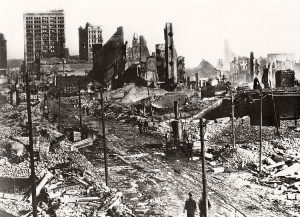 As disastrous fires go, the Great Baltimore Fire comes in historically as the third worst conflagration in an American city, surpassed only by the Great Chicago Fire of 1871, and the San Francisco Earthquake and Fire of 1906. There were other major urban disasters that were comparable in cost, but not fires. These were the Galveston Hurricane of 1900 and most recently, Hurricane Katrina that hit New Orleans and the Gulf of Mexico coast in August 2005.
As disastrous fires go, the Great Baltimore Fire comes in historically as the third worst conflagration in an American city, surpassed only by the Great Chicago Fire of 1871, and the San Francisco Earthquake and Fire of 1906. There were other major urban disasters that were comparable in cost, but not fires. These were the Galveston Hurricane of 1900 and most recently, Hurricane Katrina that hit New Orleans and the Gulf of Mexico coast in August 2005.
On February 7, 1904, a small fire was reported at the John Hurst and Company building on West German Street at Hopkins Place, The site is currently the Royal Farms Arena in the western part of downtown Baltimore. The fire started at about 10:48am, and quickly spread. It wasn’t long before the fire surpassed the ability of the city’s firefighting resources, and calls for help were telegraphed to other cities. By 1:30pm, units from Washington, DC were arriving on the Baltimore and Ohio Railroad at Camden Street Station. Officials decided to use a firebreak in an effort to halt the fires progression. They dynamited buildings around the existing fire. Unfortunately, this tactic was unsuccessful. The fire continued to rage and spread until it was finally brought under control about 5:00pm on February 8, 1904.
In the end, the fire engulfed a large portion of the city that evening. The culprit for starting the fire is believed to have been a discarded cigarette in the basement of the Hurst Building. When the fire was finally out after burning for 31 hours, an 80-block area of downtown Baltimore, stretching from the waterfront to Mount Vernon on Charles Street, had been destroyed. More than 1,500 buildings were completely leveled, and some 1,000 severely damaged, bringing property loss from the disaster to an estimated $100 million. No lives were lose in this disaster…miraculously, although some reports did claim one man died, but that was not confirmed. The fire raged from North Howard Street in the west and southwest, the flames spread north through the retail shopping area as far as Fayette Street and began moving eastward, pushed along by the prevailing winds. Amazingly, it narrowly missed the new 1900 Circuit Courthouse…now known as the Clarence M. Mitchell, Jr. Courthouse. The fire passed the historic Battle Monument Square from 1815 to 1827 at North Calvert Street, and the quarter-century-old 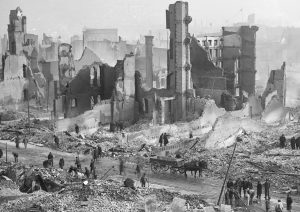 Baltimore City Hall of 1875 on Holliday Street; and finally spread further east to the Jones Falls stream which divided the downtown business district from the old East Baltimore tightly-packed residential neighborhoods of Jonestown…also known as Old Town and newly named Little Italy.” The fire burned as far south as the wharves and piers lining the north side of the old “Basin,” now the “Inner Harbor” of the Northwest Branch of the Baltimore Harbor and Patapsco River facing along Pratt Street. Also spared was Baltimore’s domed City Hall, built in 1867. The Great Baltimore Fire was the most destructive fire in the United States since the Great Chicago Fire of 1871, It destroyed most of the city and caused an estimated $200 million in property damage.
Baltimore City Hall of 1875 on Holliday Street; and finally spread further east to the Jones Falls stream which divided the downtown business district from the old East Baltimore tightly-packed residential neighborhoods of Jonestown…also known as Old Town and newly named Little Italy.” The fire burned as far south as the wharves and piers lining the north side of the old “Basin,” now the “Inner Harbor” of the Northwest Branch of the Baltimore Harbor and Patapsco River facing along Pratt Street. Also spared was Baltimore’s domed City Hall, built in 1867. The Great Baltimore Fire was the most destructive fire in the United States since the Great Chicago Fire of 1871, It destroyed most of the city and caused an estimated $200 million in property damage.

